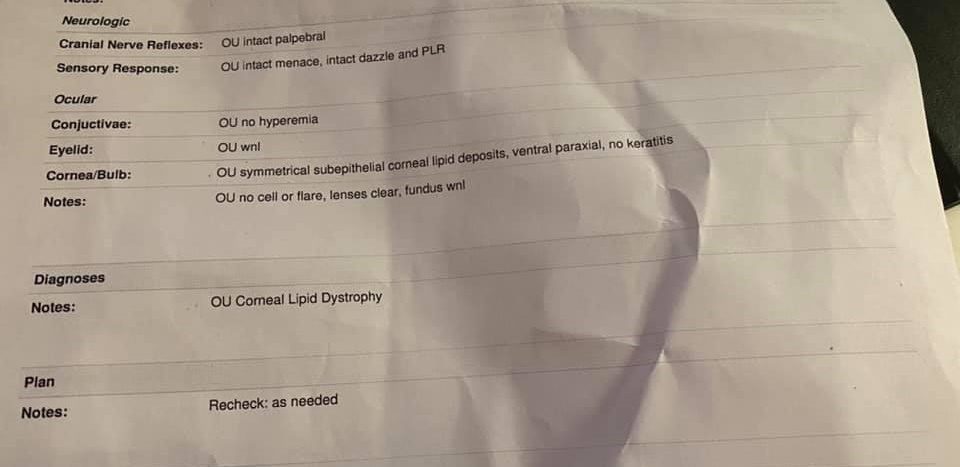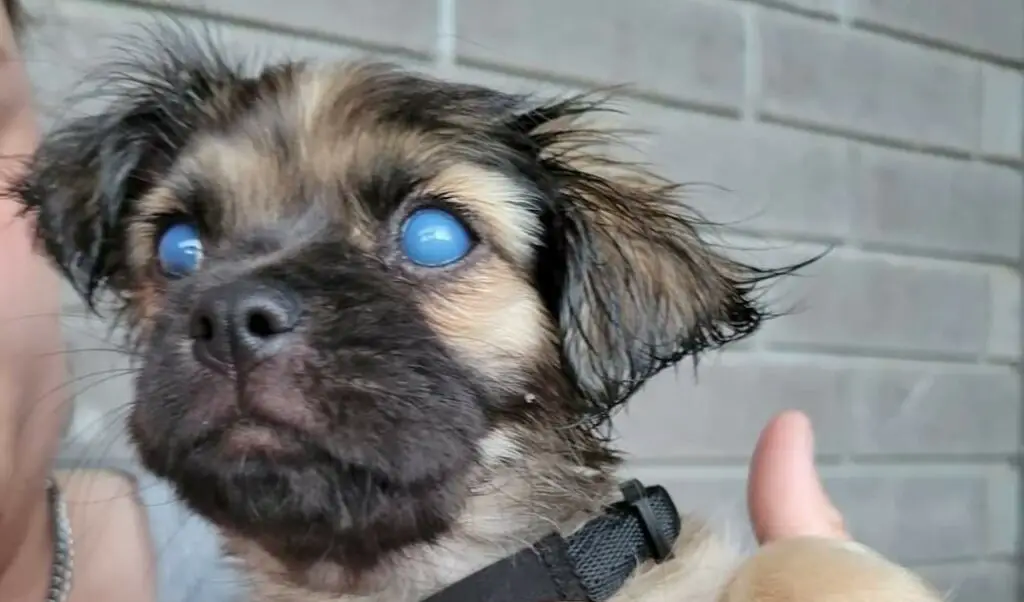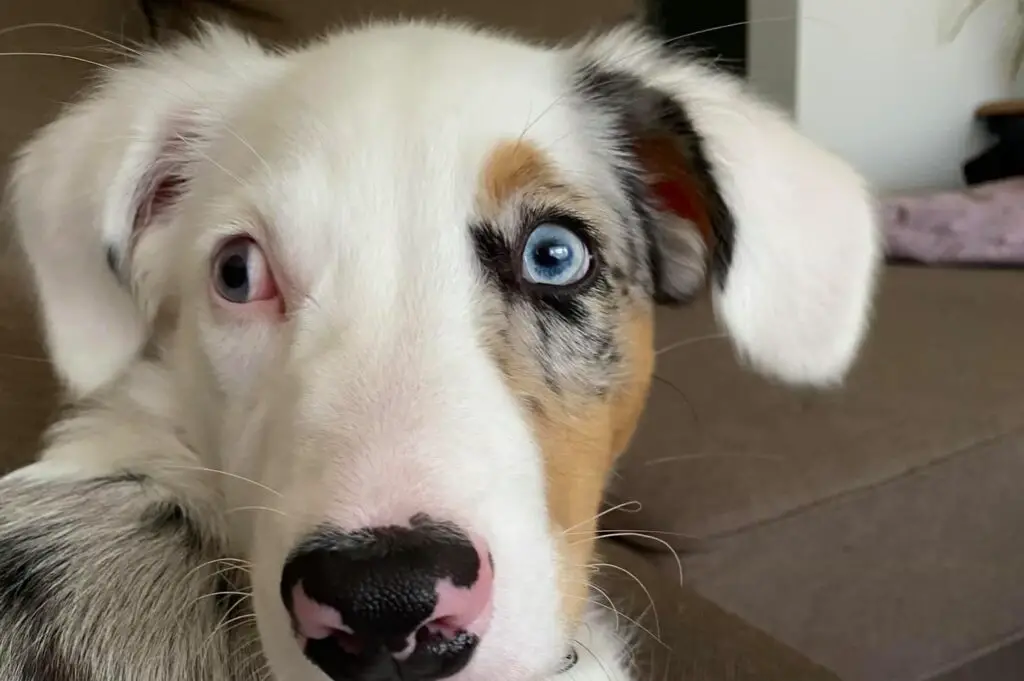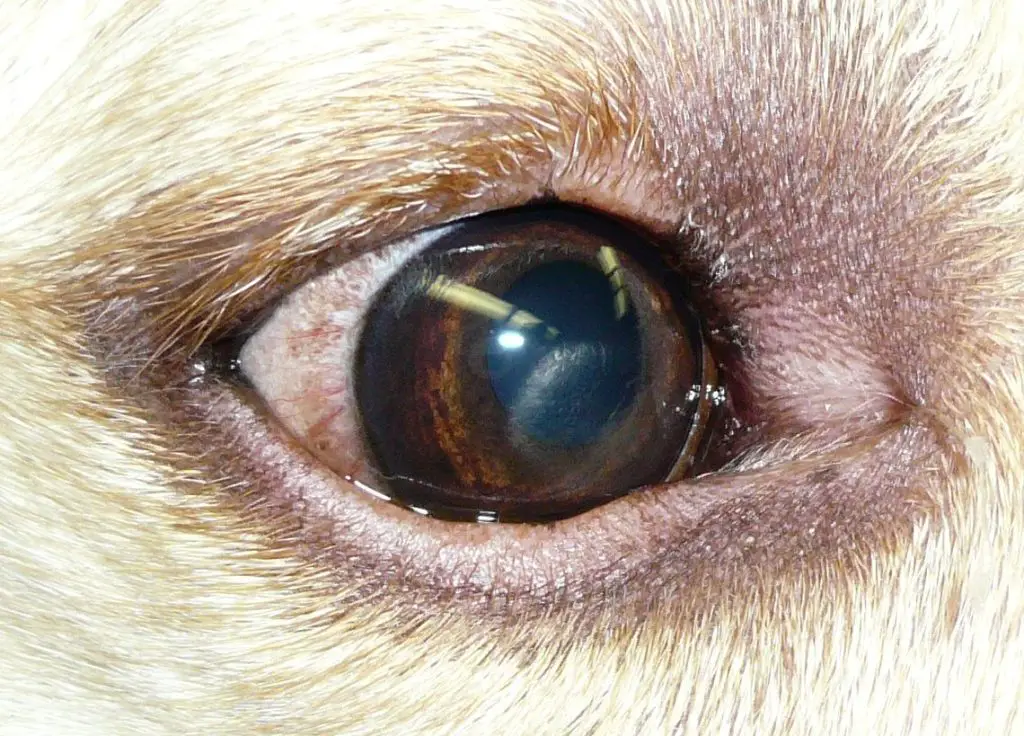Have you noticed that your dog has a blue ring around one eye? You’re not alone. This is a common condition that can occur in any breed of dog.
However, it’s important to know what causes this condition and how to treat it.
In this blog post, we will discuss the causes of a blue ring around the eye of a dog and how to get rid of it!
A blue ring around a dog’s eye can be caused by various factors including injury, infection, allergies, or conjunctivitis which is treatable through antibiotics or anti-inflammatory medication, and blue eye is caused by environmental allergies such as pollen or dust mites.
Why Does My Dog Have a Blue Ring Around Its Eye?

A dog may have a blue ring around its eye due to normal aging changes like lenticular sclerosis, increased pressure within the eyeball indicative of glaucoma, corneal edema where there is excess water in the cornea secondary to a disease process, or genetic conditions such as the Merle gene anomaly.
Lenticular Sclerosis

Lenticular sclerosis, also known as nuclear sclerosis, is a common condition in aging dogs. It’s often mistaken for cataracts due to its similar appearance.
The condition is characterized by a bluish-gray haze in the eyes, particularly noticeable under certain lighting conditions.
This happens due to the hardening and clouding of the lens. While it may slightly affect your dog’s vision, it’s not as severe or progressive as cataracts and doesn’t typically require treatment.
Glaucoma

Glaucoma is a serious eye condition that can cause a blue ring around your dog’s eye.
It occurs when the pressure within the eye increases, leading to discomfort and potential vision loss if not treated promptly.
The increased pressure can cause the cornea to become cloudy, giving it a blue or gray appearance.
Other signs of glaucoma can include excessive tearing, redness, and your dog appearing to be in pain. If you suspect glaucoma, it’s important to seek veterinary care immediately.
Conjunctivitis

Conjunctivitis, commonly known as “pink eye,” is an inflammation of the conjunctiva, the tissue coating the eye and lining the eyelids.
While it typically causes redness and discharge, in severe cases, it can cause a bluish tint around the eye.
This could be due to corneal swelling or the presence of thick mucus or pus. Conjunctivitis in dogs requires veterinary treatment, which usually involves topical antibiotics and possibly anti-inflammatory medication.
Corneal Dystrophy

Corneal dystrophy is a genetic condition that affects one or more layers of the cornea. It can cause the cornea to take on a cloudy, bluish appearance.
This condition is typically bilateral, meaning it affects both eyes. Corneal dystrophy can lead to vision problems, especially if the cloudiness is extensive.

Treatment may include topical medications to manage any associated discomfort.
Corneal Edema

Corneal edema occurs when fluid accumulates within the layers of the cornea, causing it to swell and take on a bluish hue.
It can occur due to a variety of reasons, including injury, infection, inflammation, or glaucoma.
Treatment depends on the underlying cause but often involves managing the swelling with topical medications and addressing the root cause.
Merle Gene Anomaly

In certain dog breeds, a genetic anomaly related to the Merle gene can lead to unique pigmentation of the coat and the eyes.
This can sometimes present as a blue ring around the eye, or even a completely blue eye.
Known as “Merle ocular dysgenesis,” these eye abnormalities can range from minor cosmetic differences to serious vision impairment.
If you have a Merle dog with unusual eye coloring, it’s a good idea to get their eyes checked by a vet to rule out any potential vision problems.
How Is Blue Ring In Dog’s Eyes Diagnosed

A blue ring in a dog’s eye is diagnosed by a comprehensive eye examination conducted by a veterinarian, which may include visual inspection, fluorescein staining, tonometry, and potentially more advanced diagnostic tests.
Diagnosing Lenticular Sclerosis
Lenticular sclerosis is diagnosed through a thorough eye examination by a veterinarian or a veterinary ophthalmologist.
The vet will look for the characteristic bluish-gray haze in the lens of the eye using an ophthalmoscope, a tool that allows a detailed inspection of the internal structures of the eye.
Lenticular sclerosis can often be distinguished from cataracts, a more serious condition, due to its symmetrical appearance in both eyes and the dog’s lack of significant vision impairment says VCA Hospitals.
Identifying Glaucoma
Glaucoma in dogs is diagnosed through a combination of clinical signs, physical examination, and specific diagnostic tests.
A vet may use a tonometer, an instrument that measures the pressure inside the eye, to confirm a diagnosis of glaucoma.
Other tests such as gonioscopy, which examines the eye’s drainage angle, or ocular ultrasonography, which provides images of the internal structures of the eye, may also be used as per Carolina VS.
Confirming Conjunctivitis
Conjunctivitis is typically diagnosed based on clinical signs and a physical examination of the eye.
A vet may perform a fluorescein stain test, which involves placing a non-toxic dye in the eye to highlight any damage to the cornea.
They may also take a swab of the conjunctiva for laboratory analysis to identify any bacteria or other pathogens says Blue Cross.
Detecting Corneal Dystrophy
Corneal dystrophy is usually diagnosed through a comprehensive eye exam.
The vet may use a slit lamp biomicroscope, which provides a highly magnified view of the cornea, to identify the characteristic changes of this condition.
Genetic testing may also be available for certain breeds known to be predisposed to corneal dystrophy says Wag Walking.
Diagnosing Corneal Edema
Corneal edema is diagnosed through a detailed eye examination. Using a slit lamp biomicroscope, the vet can identify the characteristic cloudiness and thickening of the cornea.
Additional tests may be performed to identify the underlying cause of the edema, such as testing for glaucoma or examining the eye for signs of injury or infection.
Recognizing Merle Gene Anomaly
The Merle gene anomaly is primarily identified based on the dog’s coat and eye color, which can be unique and varied due to this genetic factor.
However, genetic testing is available to confirm the presence of the Merle gene. For associated eye abnormalities, a thorough eye examination would be performed by a vet.
This could involve using an ophthalmoscope or other specialized equipment to check for any structural changes in the eye.
How To Treat Blue Ring In Dogs Eyes

Treating a blue ring in a dog’s eye depends on correctly identifying the underlying cause, which can range from harmless conditions like lenticular sclerosis to more serious issues like glaucoma or corneal ulcers.
Treating Lenticular Sclerosis
Lenticular sclerosis is a natural part of the aging process in dogs and doesn’t typically require treatment.
It’s often mistaken for cataracts due to its similar appearance, but unlike cataracts, it doesn’t significantly impair vision.
Regular vet check-ups are important to distinguish lenticular sclerosis from more serious conditions.
If your dog struggles with vision, consider making adjustments at home such as keeping furniture in the same place and providing well-lit paths says AnimalWised.
Managing Glaucoma in Dogs
Glaucoma in dogs is a serious condition that requires immediate veterinary attention. Treatment aims to decrease pressure within the eye and alleviate pain.
This can involve the use of topical and oral medications. In some cases, surgery might be necessary.
Long-term management may be required as glaucoma often has a tendency to recur. Regular monitoring by a veterinarian is crucial.
Handling Corneal Dystrophy
Corneal dystrophy in dogs is a genetic condition and currently, there’s no cure for it. However, the symptoms can be managed.
Lubricating eye drops or ointments can help alleviate dryness and discomfort. In severe cases affecting vision, a vet may suggest a corneal transplant.
Frontiers did a case study on Corneal Ulcers in Dogs.
Treating Corneal Edema
Treatment for corneal edema in dogs depends on the underlying cause. Topical medications can help alleviate swelling and discomfort.
If an injury or infection is causing the edema, the vet will treat the root cause. In severe cases, or if the edema is due to glaucoma, surgery might be necessary.
Managing Merle Gene Anomaly
The Merle gene anomaly is a genetic condition, and there isn’t a specific treatment for it. However, regular eye examinations can help monitor for any associated eye abnormalities.
If a dog with this anomaly develops vision problems, treatment would be based on the specific issue at hand, whether that’s medication for an associated condition like glaucoma, or surgery in more severe cases.
As always, routine vet check-ups are the best way to ensure any issues are caught early and managed effectively says Kingsdale.
When To Seek Medical Assistance For Blue Ring in Dogs Eye

If your dog has a blue ring around its eye, it’s crucial to seek veterinary assistance immediately, as this could be a symptom of several potential health issues, including serious conditions like glaucoma or corneal edema.
The appearance of a blue ring around a dog’s eye can be alarming and should never be ignored.
This change in eye color could be indicative of various ocular conditions, some of which require immediate attention.
For instance, Glaucoma, a condition characterized by increased pressure within the eye, can lead to significant discomfort and even blindness if left untreated.
Likewise, Corneal Edema, a condition where fluid accumulates in the layers of the cornea, causing it to swell and take on a bluish hue, also necessitates immediate veterinary care.
Even seemingly less severe conditions like Lenticular Sclerosis, which often presents as a bluish-gray haze in the lens of an aging dog’s eye, should be evaluated by a professional.
While this condition is typically part of the natural aging process and doesn’t significantly impair vision, a veterinary examination is essential to rule out more serious conditions.
Does a Blue Eye Mean a Dog Is Blind?
No, a blue eye doesn’t mean a dog is blind. A blue eye in a dog can be caused by albinism or merle coat patterning. Albinism is a lack of pigmentation in the skin, hair, and eyes. It’s caused by an inherited gene mutation and is relatively rare. You’ll often see blue eyes in albino animals because there’s no pigment to absorb light, so all the light reflects back out as blue.
Albinism can also cause a dog to have blue eyes. This is because the lack of pigment in the iris allows more light to pass through, giving the eye a blue appearance.
Albinism is a genetic condition that is passed down from parents to offspring. It is not caused by anything the parents did or didn’t do. Albinism occurs when there is a mutation in the genes that control pigment production.
There are two types of albinism that can affect dogs: Ocular albinism and generalized albinism. Ocular albinism only affects the eyes and leaves the coat unchanged.
Generalized albinism will affect both the eyes and coat, often causing it to be pale or white. Albinism is not a health condition and does not cause any pain or suffering. Dogs with albinism can live long and happy lives.
If you have a dog with albinism, you may want to take some extra precautions to protect its eyes from the sun. Wearing sunglasses or using eye sunscreen can help reduce the risk of damage to the eyes.
Alternatively, if your dog has a merle coat pattern (which is also caused by an inherited gene mutation), their eye color can range from brown to green to blue. The amount of blue present often depends on how much melanin the body produces overall.
How To Prevent Blue Ring Around Eyes In Dogs

Preventing a blue ring around a dog’s eyes largely involves maintaining good ocular health through regular veterinarian check-ups, proper hygiene, and a balanced diet.
Regular Veterinarian Check-ups
From my experience as a vet, I can’t stress enough the importance of regular check-ups. These visits allow for early detection of potential eye conditions that may lead to a blue ring around your dog’s eyes. Early intervention can often prevent further complications and ensure your dog maintains good vision.
Proper Hygiene
Keeping your dog’s eyes clean is crucial. As a pet owner, you should gently wipe away any discharge around your dog’s eyes with a soft, damp cloth. Avoid using harsh chemicals or human products as they can irritate your dog’s eyes.
Balanced Diet
A balanced diet plays a vital role in maintaining overall health, including eye health. Ensure your dog gets all the necessary nutrients for healthy eyes such as vitamins A, C, E, and certain antioxidants.
Protect from Injuries
Injuries can also lead to eye problems in dogs. Therefore, it’s important to protect your dog from situations that could result in eye injuries. This might include avoiding rough play with other dogs or ensuring your dog doesn’t rummage through thorny bushes.
Limit Exposure to Allergens
If your dog has allergies, exposure to allergens can lead to eye issues such as conjunctivitis, which can cause a blue ring around the eyes. By identifying and limiting exposure to these allergens, you can help prevent this condition.
FAQs
Q: Can all dogs have a blue ring around their eye?
A: No, not all dogs can have a blue ring around their eye. It is a genetic trait and only certain breeds or individual dogs may exhibit heterochromia.
Q: What are some dog breeds that commonly have heterochromia?
A: Some dog breeds that commonly have heterochromia include the Siberian Husky, Australian Shepherd, Border Collie, and Catahoula Leopard Dog.
Q: Is heterochromia in dogs a health concern?
A: In most cases, heterochromia in dogs is not a health concern. It is typically a harmless and purely aesthetic feature. However, if you notice any other abnormal symptoms or changes in your dog’s eye, it is recommended to consult a veterinarian.
Q: Is heterochromia in dogs more common in certain coat colors?
A: Heterochromia is not specifically related to coat color in dogs. It can occur in dogs of any coat color or pattern.
Q: Can the blue ring around a dog’s eye change in color?
A: While it is rare, the color of the blue ring in a dog’s eye can sometimes change over time. It may become darker or lighter, but this is not common.
Q: Can a dog be born with heterochromia or does it develop later in life?
A: Dogs can be born with heterochromia, meaning they have different eye colors from birth. However, it can also develop later in life as a result of injury, disease, or age-related changes.
Q: Can the blue ring around a dog’s eye affect its vision?
A: In most cases, heterochromia does not affect a dog’s vision. It is usually a cosmetic feature and does not cause any vision problems. However, if your dog is experiencing any eye-related issues, it is best to consult with a veterinarian.
Q: Is heterochromia more common in certain age groups of dogs?
A: Heterochromia can occur in dogs of any age. It can be present from birth or develop later in life, regardless of the dog’s age.
Q: Can a dog with heterochromia have any additional health problems?
A: Heterochromia itself is not associated with any specific health problems in dogs. However, it is always important to monitor your dog’s overall health and well-being and consult a veterinarian if you notice any concerning symptoms.
Conclusion and final thoughts
In conclusion, the blue ring around a dog’s eye can be caused by many different conditions, but one of the most common is a corneal ulcer.
This condition can be very painful for dogs and requires prompt medical attention. It is important to take your dog to the vet if you suspect it has a corneal ulcer in order to get proper treatment.
With early diagnosis and treatment, most corneal ulcers can be successfully treated and will not cause any long-term damage or problems.




